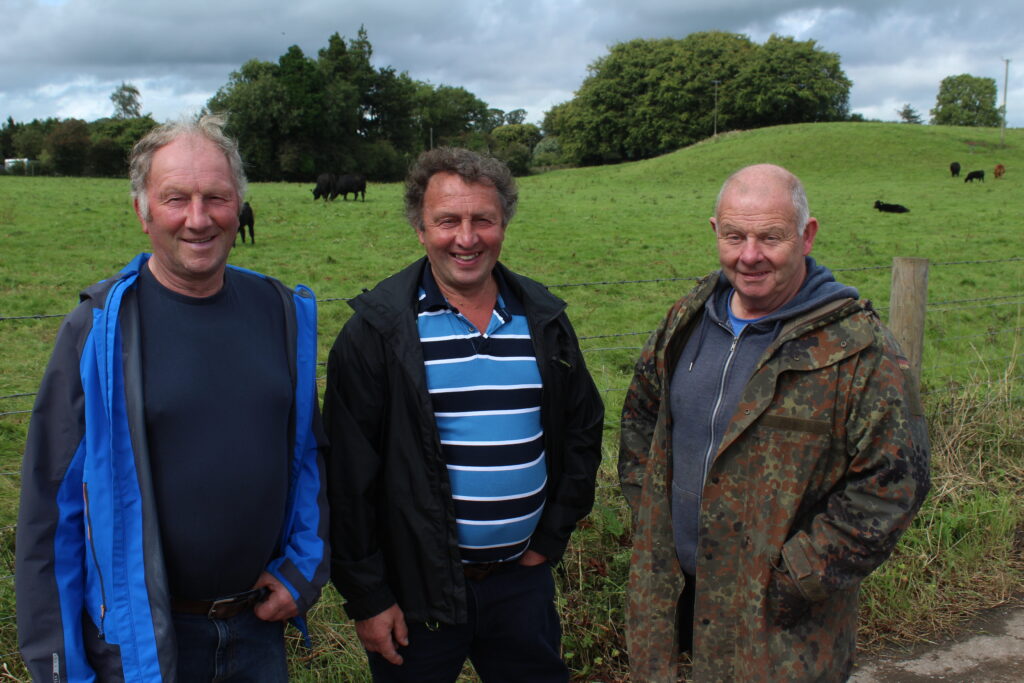The growth in red Aberdeen Angus cattle numbers continues apace in Northern Ireland. And this is not a fad.
The recent farm walk hosted by Fivemiltown-based, pedigree Angus breeder – Ian Browne – provided a perfect platform for an in depth discussion on this subject.
Ian farms with his son Harry on a productive grassland farm, located right on the border between counties Tyrone and Fermanagh.

Their pedigree Angus herd comprises 100 cows and followers. It is one of the most significant breeding operations of its kind in Northern Ireland. Ian and Harry also keep a small number of pedigree Hereford cattle.
Their Angus herd contains 20 red-coloured breeding females.
“The vast bulk of our customers are dairy farmers looking to buy black Aberdeen Angus bulls,” Ian explained.
“They are looking for an animal that will produce a high quality calf that is eligible for all of the current Aberdeen Angus beef quality schemes.
“However, there is a growing demand for red Angus bulls within the suckler sector. When crossed, with a Charolais cow, for example, the resulting calf has that deep cream colour that is widely sought by beef finishers.”
Black or red Aberdeen Angus
According to Ian Browne, there is no difference in the overall performance levels that can be achieved by red and black coloured Angus cattle.
“The difference in coat colour is the only factor coming into play,” he explained.
Crossing a red Aberdeen Angus bull with a black cow will always produce a black calf and vice versa. The production of a red calf will only be guaranteed when a red bull is crossed with a red cow.
“However, the red trait can come through in the second generation,” Ian added.
“We have 20 red cows in the herd at the present time. The plan is to keep numbers at this level.”
It turns out that Europe is out of step with the rest of the world, where red Aberdeen Angus cattle predominate.

They are the predominant Angus option in the United States, Canada, across South America and Australia.
Red is a naturally occurring colour trait within the Aberdeen Angus breed; it is not a mutation.
It has been the case that black cattle have been chosen as the bloodlines of choice in the UK and Ireland for many generations.
Genetic assessment has confirmed that, coat colour apart, red Angus animals are identical to the Scottish population of Aberdeen Angus cattle.
Today, red Angus stock are registered separately from black Angus cattle in Australia, Canada, and the United States.

Red Angus cattle are naturally polled. Mature bulls have an average live weight of 935kg; the equivalent figure for cows is 635kg.
The Scottish Angus is usually black, but red individuals occur. This may be the consequence of cross-breeding in the 18th century of the small Scottish cattle with larger English Longhorn stock, aimed at increasing their draught power.
Management
Making best use of grazed grass is an absolute priority for Ian Browne. He puts the bulls out with the cows and heifers at the beginning of July.
This means that the first calves of the year are not born until April.
“The vast majority of our mature cows will calve outdoors without assistance,” Ian commented.
“Obviously, we keep a closer eye on first-calving heifers. We do not feed creep to calves at all. The only animals on the farm receiving meal are young breeding bulls in preparation for sale.
“Our breeding bulls are sold at around 18 months of age. They are brought together in groups of 10 with potential buyers given full access to all the animals for sale at a particular time.”

The myriad quality beef schemes continue to encourage demand for Aberdeen Angus cattle across the island of Ireland. As part of this, all pedigree Angus cattle are fully genotyped at birth.
The beef industry across the UK and Ireland is changing with dairy calf-to-beef systems rising in prominence.
Farmers adopting these systems are more than happy to work with Aberdeen Angus cross calves, provided they are of a suitable quality.
College of Agriculture Food and Rural Enterprise (CAFRE) beef and sheep advisor, Gareth Beacom, was the guest speaker at the farm walk hosted by Ian Browne.

Courtesy of his presentation, he highlighted the central role that grazed grass can play within all livestock production systems.
“Grazed grass remains the cheapest feed that farmers can offer their stock. It costs 6p to produce one kg of grass dry matter; the equivalent figures for silage and concentrates are 12p and 27p respectively,” Beacom explained.
“GrassCheck figures confirm that grass crude protein figures will remain at around 20% throughout the grazing season.
“This fact alone makes grass a very valuable feed input, when one compares the cost of procuring meals with a similar protein value.
“However, the energy contained within grass swards will vary throughout the year, decreasing as the autumn period approaches,” he added.
Beacom explained that it is possible to finish cattle on grazed grass alone during the early summer period adding that offering meals at this stage is simply adding costs for no reason.
“The cattle will take the meals offered to them. But they will only be substituting the concentrate for the grass that is already available to them,” Gareth added.
“Maximising the energy intake of cattle during the finishing period is crucially important. This ensures that the animals have the correct level of fat cover.
“Animals can be finished at grass during the autumn period. But meal supplementation will be necessary in order to ensure that energy intakes are at the correct levels.”#

